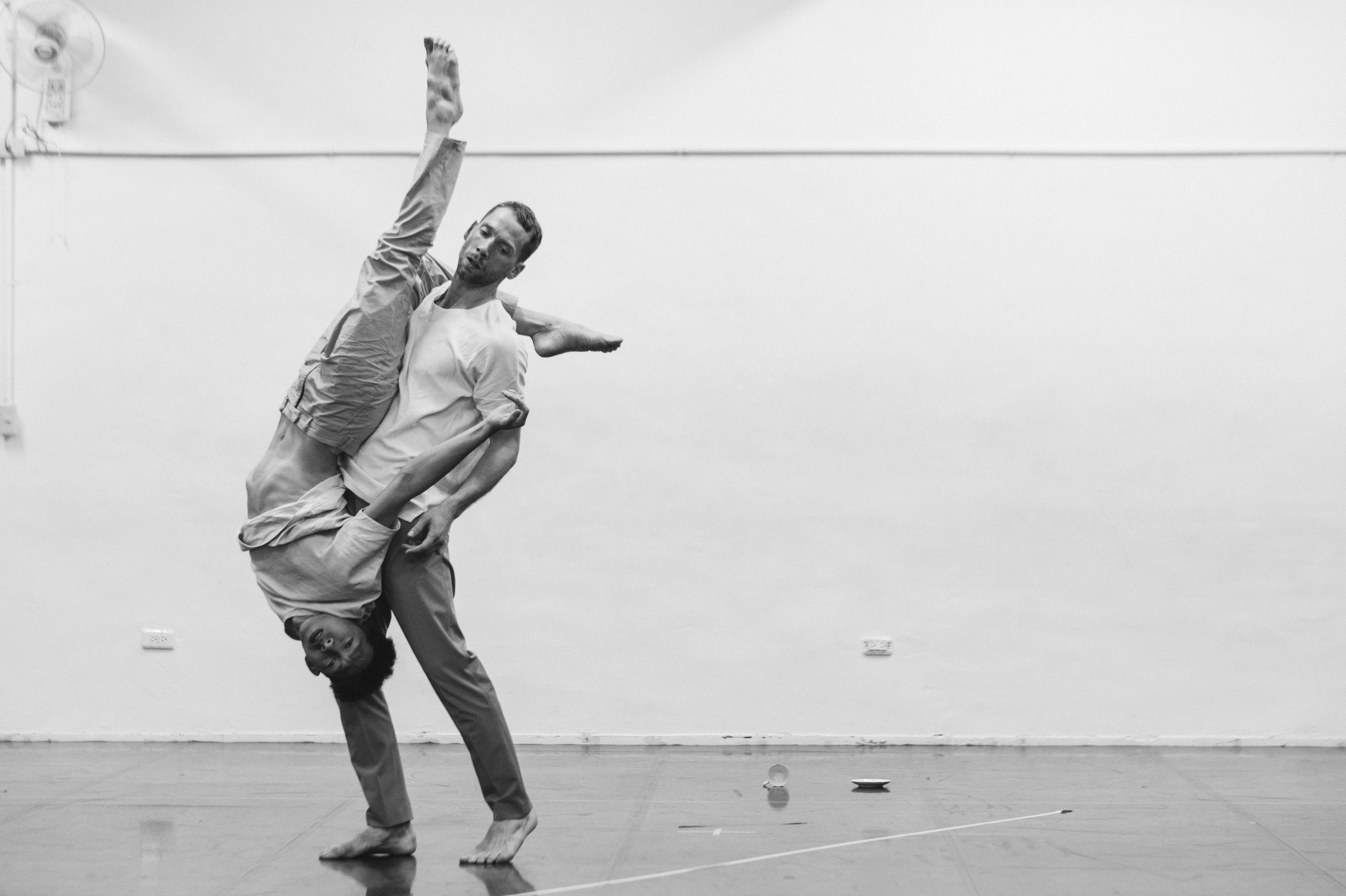「It takes two to tango」為英文諺語,中文翻譯為「一個巴掌拍不響」,意指有爭端時兩個人都該負責,通常在暗示吵架時兩個人都有錯。
在創作時,聯合國世界人權宣言條例引發了凃力元的靈感,他試圖用身體去詮釋條例。從最大的人權關注,縮小聚焦到兩個人的關係,這兩人可以代表任何人、國家、社會、種族,經歷著不同階段的歷史時刻或人生記憶片段,相遇、分離、競爭、逃離,也有可能是最後的妥協。
在歐洲親身經歷過難民潮,讓凃力元對人們本身存在及互動關係有了更深刻的體會。舞作呈現出北歐冷冽的風格,利用極簡藍白日光燈的變化,營造出時下科技發達,人與人關係看似靠近卻實而疏離的空虛感。對於凃力元而言,這作品是一個里程碑,是在滿30歲之前對自己和對現下社會給出的溫柔一擊,不重但很沉。
“It takes two to tango” is an English idiom that is often equated with the Chinese saying that “a single slap in the face doesn’t make a sound,” meaning that both parties are responsible in any quarrel, as both are to blame in a conflict.
Articles in the United Nation’s Declaration of Human Rights inspired TU Lee-Yuan in the process of creating this work, where he attempts to interpret these articles with his body, narrowing the focus of the greatest concern for human rights to the relationship between two people. These two people can represent any person, nation, society, or race, each with their respective experiences of historical moments, or life memories as they engage in an encounter, a separation, a competition, escape, or possibly a final compromise.
A personal experience with the refugee crisis in Europe gave TU Lee-Yuan a deep empathy for existence and the interactive relationship between human beings. The dance work reveals the cool detachment of Nordic-style. Using minimalistic shifts between blue and white florescent lighting, he creates a sense of the emptiness in human relationships under technological advances that seem to create intimacy but are in actuality alienating.
For TU Lee-Yuan, this work is a milestone before the artist turns 30; it is a gentle blow – not heavy-handed, but weighty -- delivered to the self and to the present society.
凃力元 TU Lee-Yuan
現為瑞典哥德堡歌劇院舞團(GöteborgsOperans Danskompani)舞者,2011年畢業於國立臺北藝術大學,同年加入玫舞擊,演出《紙境》。2013年加入瑞典哥德堡歌劇院舞團至今。曾與Marcos Morau, Sharon Eyal、Ohad Naharin、Sidi Larbi Cherkaoui、Saburo Teshigawara、Anton Lachky、Alan Lucien Øyen and Marina Mascarell等國際編舞家一同工作。參與作品風格多元創新,並於2015年獲得觀眾票選最佳男舞者。 2016年舉辦生平首次互動攝影展「Humans and Flowers」。
Currently a dancer with the Göteborgs Operans Danskompani in Sweden, TU Lee-Yuan graduated from the Taipei National University of the Arts in 2011, and joined the Meimage Dance Company, performing in the work Beyond the Pale. Since joining the Göteborgs Operans Danskompani in 2013, he has worked with international choreographers including Marcos Morau, Sharon Eyal, OhadNaharin, Sidi Larbi Cherkaoui, Saburo Teshigawara, Anton Lachky, Alan Lucien Øyen, and Marina Mascarell. He has participated in numerous innovative and stylistically diverse projects, and was voted Best Male Dancer by the audience in 2015. In 2016, he held his first interactive photographic exhibition, Humans and Flowers.
郎祖明
何曉玫
凃力元、Jan Spotak
凃力元、Jan Spotak
Jan Spotak
華山1914文化創意產業園區—烏梅劇院
關鍵字
藝術家談作品
「我希望不同國籍的人們看了這支作品,都能夠產生共鳴。」
「It takes two to tango」為英文諺語,中文翻譯為「一個巴掌拍不響」,意指有爭端時兩個人都該負責,通常在暗示吵架時兩個人都有錯。「這個諺語用來表達我的舞作,真是太貼切了!」旅居瑞典的舞者凃力元興奮地說著。
的確,無論在舞蹈形式或意義上,「It takes two to tango」都恰如其分的說明了凃力元試圖探討人際關係的那份用心。
來自聯合國世界人權宣言的靈感
凃力元說,旅居瑞典的這幾年,感受最深的莫過於難民潮,這些在瑞典街頭乞討的吉普賽人和敘利亞難民,帶給他很大的衝擊。「從某個角度來看,我們都是新移民,然而我享有工作和薪水,生活顯然好很多。」他常這麼想著,「人們為何會有階級和種族之分?」
在一次阿姆斯特丹的假期中,凃力元偶然在飯店抽屜裡發現一本「聯合國世界人權宣言」,當他看到上面寫著:「人們有居住、遷徙和移動的自由。」令他格外感慨,也觸發了他的靈感,他與斯洛伐克的舞伴討論著,人與人之間若是剝除了外加的限制與成見,是不是更能真誠的溝通呢?
於是,他們試著用身體去詮釋條例,從最大的人權關注,縮小聚焦到兩個人的關係,這兩人可以代表任何人、國家、社會、種族,經歷著不同階段的歷史時刻或人生記憶片段,相遇、分離、競爭、逃離,也有可能是最後的妥協。他們有時相互依偎,有時卻互相牽制,限制了彼此的自由,就像是對人權條例的反諷。
具有象徵意義的古董咖啡杯與瓷盤
舞作中,凃力元利用極簡藍白日光燈的變化,呈現出北歐冷冽的風格,也營造出時下科技發達,人與人關係看似靠近卻實而疏離的空虛感。而舞者手上拿著的古董咖啡杯與瓷盤,更吸引了觀眾的目光。
凃力元說,瑞典文有個單字fika,意思是「一起喝咖啡」,它可以是動詞,也可以是名詞,任何時間皆可fika,但前題是必須兩人以上,若只有一人便稱不上fika了。他將fika的概念也帶到舞作中,還特地到二手商店找了一套復古瓷器茶具,一方面呼應「喝咖啡」的意象,另一方面則讓咖啡杯與瓷盤代表「我們生命中自認為不可輕忽的重要東西」,它可能是回憶,可能是國籍,可能是facebook裡的likes,也可能就是阿嬤一代一代傳下來的瓷茶杯。這些代表著我們身份的外在東西,是什麼樣的一個存在?是壓力、鼓勵?是面具?還是防彈背心?
舞台上,兩位舞者各自拿著杯與盤,彼此磨合著,在手臂的推移之間,杯盤幾度聚散,最後掉落摔碎,舞者們看似失去了重要的東西,然而在遺憾的眼神中,回頭又看到了彼此。「當我們放棄了附加的那些價值或背景,我們看到的就只不過是人,很單純的兩個人,很真心想要溝通的兩個人。」凃力元說。
在歐洲親身經歷過的難民潮,讓凃力元對人們本身存在及互動關係有了更深刻的體會。有趣的是,在台灣的演出結束後,一位媽媽在舞團臉書留言,表示自己看了此舞之後,覺得她和先生之間的關係似乎有了轉圜的空間……這讓凃力元既驚訝又感動,他更深刻體會——藝術家是可以創作一些作品讓人反思的。
「我希望不同國籍的人們看了這支作品,都能夠產生共鳴。」對於凃力元而言,《It Takes Two to Tango》是一個里程碑,是在滿30歲之前對自己和對現下社會給出的溫柔一擊,不重但很沉。
評審談作品
肢體語彙的文法邏輯巧妙地擺盪在現實與隱喻之間,讓舞者的真實情感在形式技巧當中滲透而出。
入圍理由
一個瓷器茶杯擺放在兩位舞者的手臂上,於是舞者的動作必須小心翼翼。編舞家將舞者的身體放置於物件的現實條件當中,從即物性的動作裡抽取舞蹈語彙,表現在雙人關係當中自我主體的壓迫與消融。肢體語彙的文法邏輯巧妙地擺盪在現實與隱喻之間,讓舞者的真實情感在形式技巧當中滲透而出。燈光、音樂與舞台裝置的運用讓舞蹈簡潔有力,去除所有情緒性的修辭與敘事性的文藻,直接表達人的存在狀態與人際關係本身。「下午茶」是西方文化的禮節,編舞者謹慎控制文化意涵,讓觀眾從東方與西方舞者的身上解讀出東西方文化衝突之意涵成為可能。這是一個讓人屏息直視雙人關係的精彩作品。(主筆/林于竝)
Comments on the finalist artworks
Placed on the arms of two dancers is a porcelain tea cup. Consequently, the dancers must be extremely careful with their movement. The choreographer conditions the dancers’ bodies with a real object, and extracts a dance vocabulary from the movement informed by new objectivity. The vocabulary speaks about the oppression and disintegration of one’s subjectivity in a relationship. The syntax and logic of the body language subtly oscillates between reality and a metaphorical level, allowing the dancers’ real emotions to sieve through the form and techniques. The use of lighting, music and stage renders the dance succinct and powerful, without any emotional rhetoric and narrative addition so that human existence and interpersonal relationships can be candidly delineated. “Afternoon tea” embodies the Western culture and etiquette. The choreographer has meticulously overseen the cultural meaning, creating a possibility for the audience to read the clashing of Eastern and Western cultures delineated by the Asian and Western dancers. This is a compelling piece that draws the audience in to look into the relationship between two people. (Commentator: LIN Yu-Pin)






